
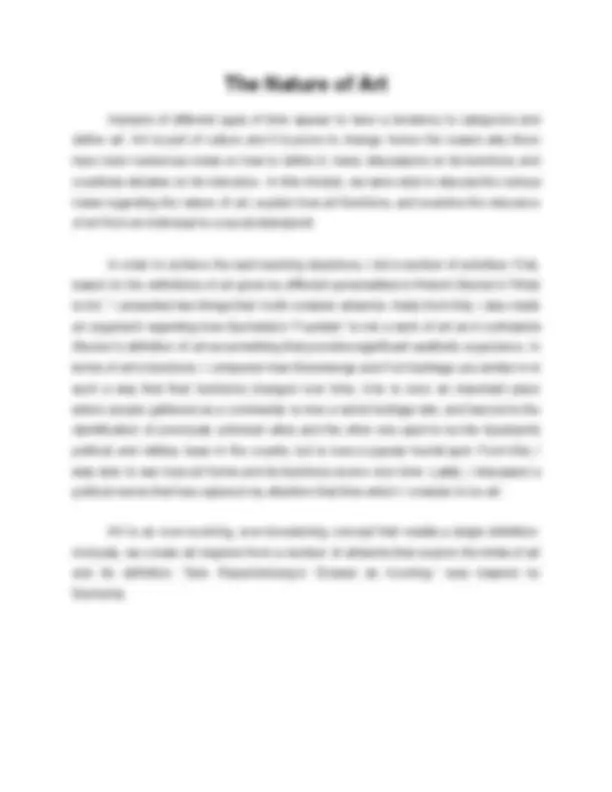
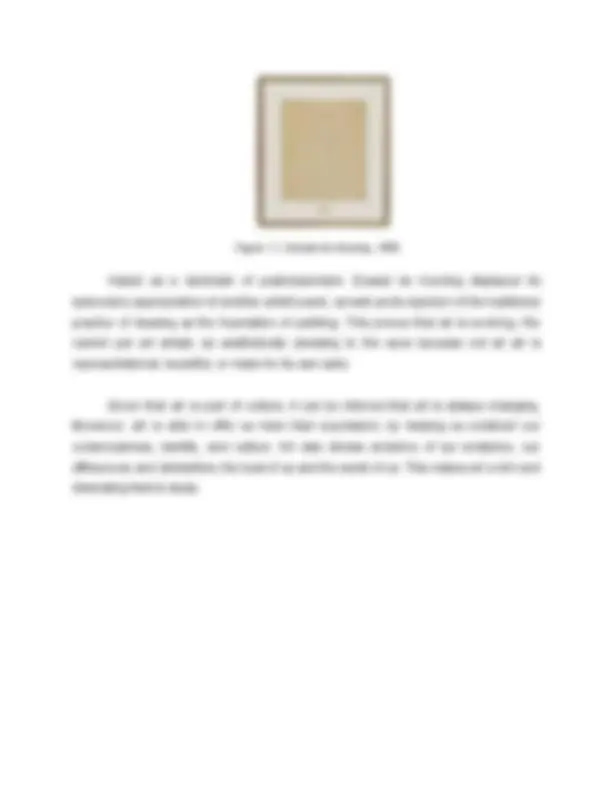
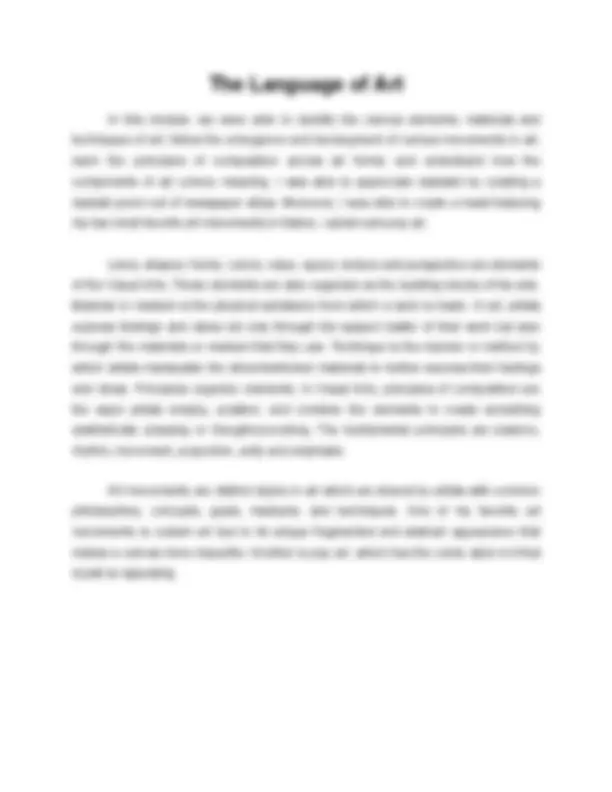
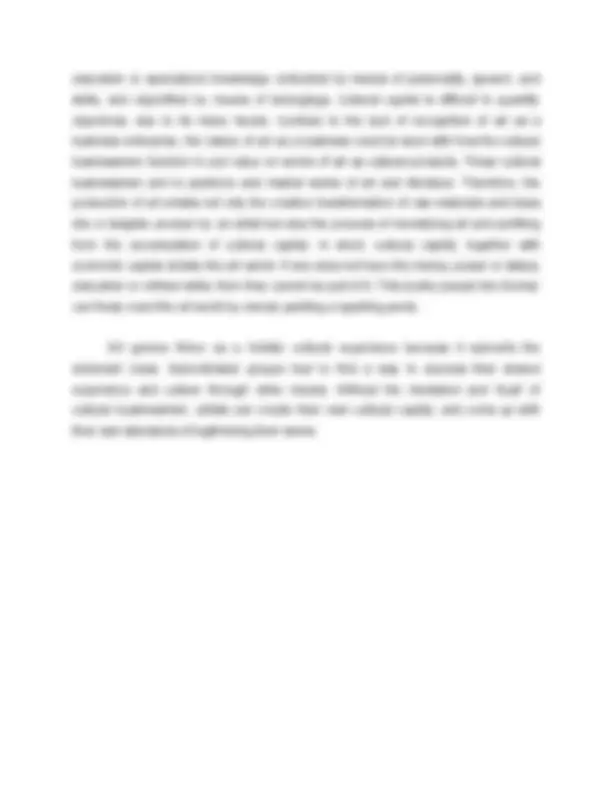
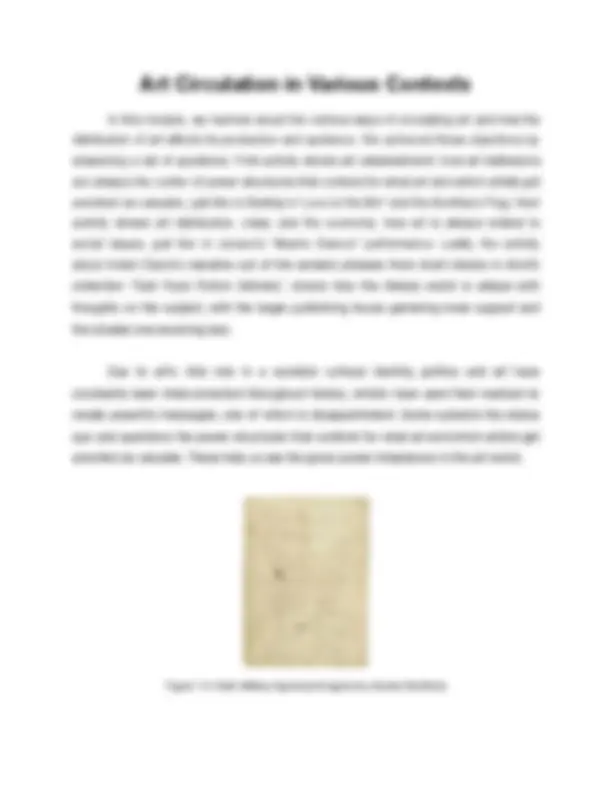
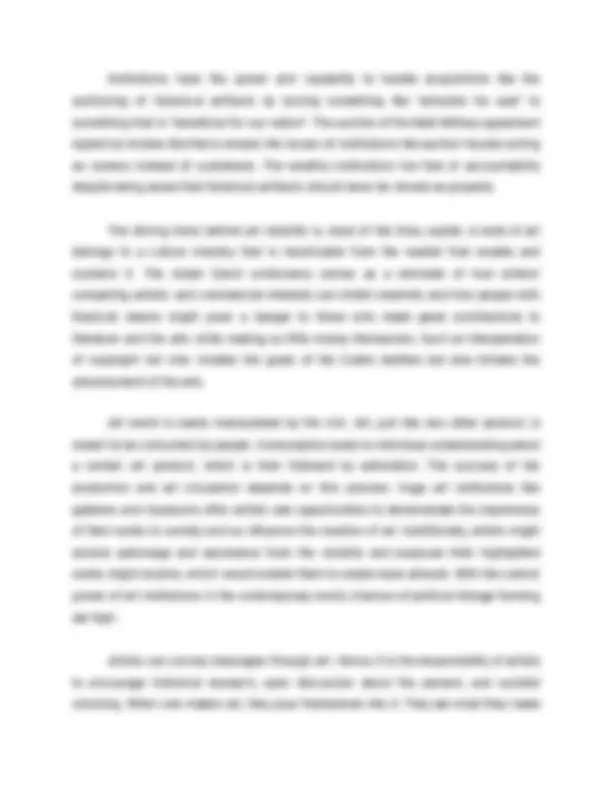
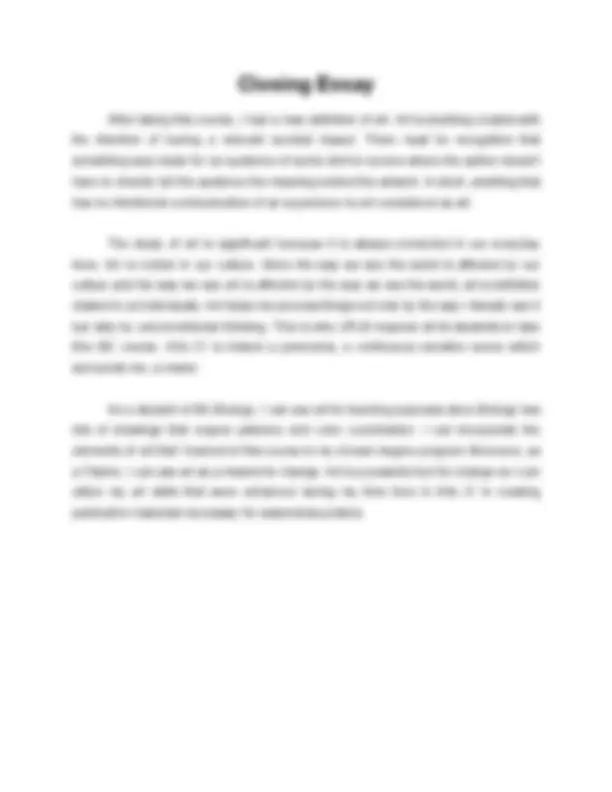



Study with the several resources on Docsity

Earn points by helping other students or get them with a premium plan


Prepare for your exams
Study with the several resources on Docsity

Earn points to download
Earn points by helping other students or get them with a premium plan
Community
Ask the community for help and clear up your study doubts
Discover the best universities in your country according to Docsity users
Free resources
Download our free guides on studying techniques, anxiety management strategies, and thesis advice from Docsity tutors
Due to art's vital role in a society's cultural identity, politics and art have constantly been interconnected throughout history.
Typology: Study notes
1 / 14

This page cannot be seen from the preview
Don't miss anything!









Prior to taking any art-related class, the first thing that comes to my mind when I hear the word art is canvas. That was where my idea of art being something one could excel at through practice came from. As I began studying arts in high school, I learned that art is more than just canvas. Speech choir performances, thousand cranes origami, and my favorite P-Pop songs are also considered works of art. Technically, anything that is aesthetically pleasing to the eyes and has a hidden meaning behind it is art for me. Prior to taking this course, my definition of art went from “ anything that is aesthetically pleasing to the eyes and has a hidden meaning behind it” to “a form of expression”. It is through art that people can convey how it felt to be alive at a certain point in time. Art is a powerful tool for communicating one's intellectual and emotional insights to the masses and challenging the status quo. Studying arts enhances intellectual and emotional knowledge of a person. It is through art that I understand underlying messages beyond language. Works of art evoke feelings of wonder or skepticism, hope or despair, adoration or spite; they can be simple or sophisticated, or delicate or explicit. Either way, art changed my perspective of the world. I got my title “Shoot! Take a Panorama” from a lyric of a song entitled panorama. The idea behind this is that my whole arts learning experience is like taking a panorama shot of the art world. There was a lot of art to learn and the shot goes on and on as long as there is art.
Figure 1.1. Erased de Kooning, 1953 Hailed as a landmark of postmodernism, Erased de Kooning displayed its subversive appropriation of another artist’s work, as well as its rejection of the traditional practice of drawing as the foundation of painting. This proves that art is evolving. We cannot put art simply as aesthetically pleasing to the eyes because not all art is representational, beautiful, or made for its own sake. Given that art is part of culture, it can be inferred that art is always changing. Moreover, art is able to offer us more than expression, by helping us construct our consciousness, identity, and culture. Art also shows evidence of our existence, our differences and similarities, the best of us and the worst of us. This makes art a rich and interesting field to study.
In this module, we were able to identify the various elements, materials and techniques of art; follow the emergence and development of various movements in art; learn the principles of composition across art forms; and understand how the components of art convey meaning. I was able to appreciate dadaism by creating a dadaist poem out of newspaper strips. Moreover, I was able to create a mask featuring my two most favorite art movements in history: cubism and pop art. Lines, shapes, forms, colors, value, space, texture and perspective are elements of the Visual Arts. These elements are also regarded as the building blocks of the arts. Material or medium is the physical substance from which a work is made. In art, artists express feelings and ideas not only through the subject matter of their work but also through the materials or medium that they use. Technique is the manner or method by which artists manipulate the aforementioned materials to further express their feelings and ideas. Principles organize elements. In Visual Arts, principles of composition are the ways artists employ, position, and combine the elements to create something aesthetically pleasing or thought-provoking. The fundamental principles are balance, rhythm, movement, proportion, unity and emphasis. Art movements are distinct styles in art which are shared by artists with common philosophies, concepts, goals, mediums, and techniques. One of my favorite art movements is cubism art due to its unique fragmented and abstract appearance that makes a canvas more impactful. Another is pop art, which has the comic style in it that is just so appealing.
over the ideologies they can inject into these products, and they are able to maintain the status quo together with their position and power. An example of this is museums that only curate and display works of those who are already heavily connected to big names and networks. Several well-known celebrities have entered the realm of visual art like Richard Gomez, Heart Evangelista, and Solenn Heussaff. They gained a respectful reputation in the world of art mostly due to their fame and privilege, allowing them to exhibit their works in prestigious art institutions and art fairs like Manila Art, The Art Fair Philippines, and the Ayala Museum. Gomez’s acrylic painting entitled “OOOOHH” featuring a yellow squirting penis against a black canvas, was exhibited as part of ManilArt held at SM Aura Premier. Its price tag, almost two hundred thousand pesos, became even more controversial than the art itself. Figure 1.3. OOOOHH, 2019 When we view art as a dispensable object—something that we can purchase, trade, or even dispose of if need be—it becomes a commodity. When art is stripped of its cultural, historical, and societal value and identity, it enters commodification. Analyzing art and its production reminds us not to be passive consumers and observers of art but rather critics of the various institutions that mold the production of art that is later on processed and shaped for our consumption. Cultural capital refers to assets that allow us to move up the social ladder. These assets, like skills and music taste, are both tangible and intangible. Cultural capital could be institutionalized by means of
education or specialized knowledge; embodied by means of personality, speech, and skills; and objectified by means of belongings. Cultural capital is difficult to quantify objectively due to its many facets. Contrary to the lack of recognition of art as a business enterprise, the nature of art as a business could be seen with how the cultural businessmen function to put value on works of art as cultural products. These cultural businessmen aim to publicize and market works of art and literature. Therefore, the production of art entails not only the creative transformation of raw materials and ideas into a tangible product by an artist but also the process of monetizing art and profiting from the accumulation of cultural capital. In short, cultural capital, together with economic capital dictate the art world. If one does not have the money, power or status, education or refined skills, then they cannot be part of it. This is why people like Gomez can freely roam the art world by merely painting a squirting penis. Art genres thrive as a holistic cultural experience because it subverts the dominant class. Subordinated groups had to find a way to express their shared experience and culture through other means. Without the mediation and ‘trust’ of cultural businessmen, artists can create their own cultural capital, and come up with their own standards of legitimizing their works.
Institutions have the power and capability to handle acquisitions like the auctioning of historical artifacts by turning something like “artworks for sale” to something that is “beneficial for our nation”. The auction of the Naik Military agreement signed by Andres Bonifacio reveals the issues of institutions like auction houses acting as owners instead of custodians. The wealthy institutions live free of accountability despite being aware that historical artifacts should never be viewed as property. The driving force behind art mobility is, most of the time, capital. A work of art belongs to a culture industry that is inextricable from the market that creates and sustains it. The Adam David controversy serves as a reminder of how writers' competing artistic and commercial interests can inhibit creativity and how people with financial means might pose a danger to those who make great contributions to literature and the arts while making so little money themselves. Such an interpretation of copyright not only violates the goals of the Code's drafters but also hinders the advancement of the arts. Art world is easily manipulated by the rich. Art, just like any other product, is meant to be consumed by people. Consumption leads to individual understanding about a certain art product, which is then followed by admiration. The success of the production and art circulation depends on this process. Huge art institutions like galleries and museums offer artists rare opportunities to demonstrate the importance of their works to society and so influence the creation of art. Additionally, artists might receive patronage and assistance from the visibility and exposure their highlighted works might receive, which would enable them to create more artwork. With the current power of art institutions in the contemporary world, chances of political linkage forming are high. Artists can convey messages through art. Hence, it is the responsibility of artists to encourage historical research, open discussion about the present, and societal visioning. When one makes art, they pour themselves into it. They are what they make
and thus, art and its artist are inseparable. The extensive network of relationships and exchanges that starts with the artists themselves are demonstrated by the circulation of art. Art dealers, collectors, and commissioners join artists in their journey of art production. From this, we can infer that those in power can manipulate art production and dictate art circulation in favor of them. Art organizations rely significantly on wealthy individuals for funding. The same thing goes with artists. Individuals sponsoring artists make artists visible in the art world since they have the resources and connections to bring the best exposure for an artwork. No matter how one looks at it, museums and art galleries are very much related to systems of exploitation.
In this module, we learned about some factors that can influence how we receive art; how technology affects the way we perceive and value art; and how art can stimulate the intellect and foster criticality. We were able to achieve these goals by doing the Dugtungan activity where we were grouped into four individuals and each of us created a short story out of the story written by the previous writer. The way we perceive the world influences the reception of many works of art and design, just as the Gestalt principles of perceptual organization states. In its most basic form, gestalt theory holds that the human brain will attempt to simplify and organize complex images or designs with many elements by subconsciously arranging the parts into an organized system that creates a whole, rather than just a series of individual pieces. Under the gestalt principles there is what we call the Law of Similarity which states that the human eye makes relationships between similar elements. The usual communication model is that the sender produces the message, creates/fixes its meaning and the said message is communicated to the audience directly. According to Hall, the audience are not mere receivers but generators of meaning. Messages are also not as transparent. The nature of communication adheres
After taking this course, I had a new definition of art. Art is anything created with the intention of having a relevant societal impact. There must be recognition that something was made for an audience of some kind to receive where the author doesn’t have to directly tell the audience the meaning behind the artwork. In short, anything that has no intentional communication of an experience is not considered as art. The study of art is significant because it is always connected in our everyday lives. Art is rooted in our culture. Since the way we see the world is affected by our culture and the way we see art is affected by the way we see the world, art is definitely related to us individually. Art helps me process things not only by the way I literally see it but also by unconventional thinking. This is why UPLB requires all its students to take this GE course. Arts 21 is indeed a panorama, a continuous narrative scene which surrounds me, a viewer. As a student of BS Biology, I can use art for learning purposes since Biology has lots of drawings that require patience and color coordination. I can incorporate the elements of art that I learned in this course to my chosen degree program. Moreover, as a Filipino, I can use art as a means for change. Art is a powerful tool for change so I can utilize my art skills that were enhanced during my time here in Arts 21 in creating publication materials necessary for awareness posters.
Centenario, Cinema. “LIWAY, 2018.” Twitter , Twitter, 1 Apr. 2020, https://twitter.com/phcinema100/status/1245363602510327809. Kirti, Kamna. “How an Erased Painting Became a Controversial Art Piece.” Medium , The Collector, 3 Feb. 2021, https://medium.com/the-collector/how-an-erased-painting-became-a-controversial-art-piec e-a2f9160b9a31. Limos, Mario Alvaro. “Richard Gomez Explains Meaning behind Viral Yellow Painting.” Esquiremag.ph , Esquire Philippines, 1 Jan. 1970, https://www.esquiremag.ph/culture/books-and-art/richard-gomez-viral-painting-a00293-
Santiago, Katrina. “Opinion: Historical Documents Belong to the Nation, Not in Private Collections.” CNN , 2018, https://www.cnnphilippines.com/life/culture/2018/12/17/historical-documents-auction.html. Tate. “Political Pop.” Tate , 2020, https://www.tate.org.uk/art/art-terms/p/political-pop.